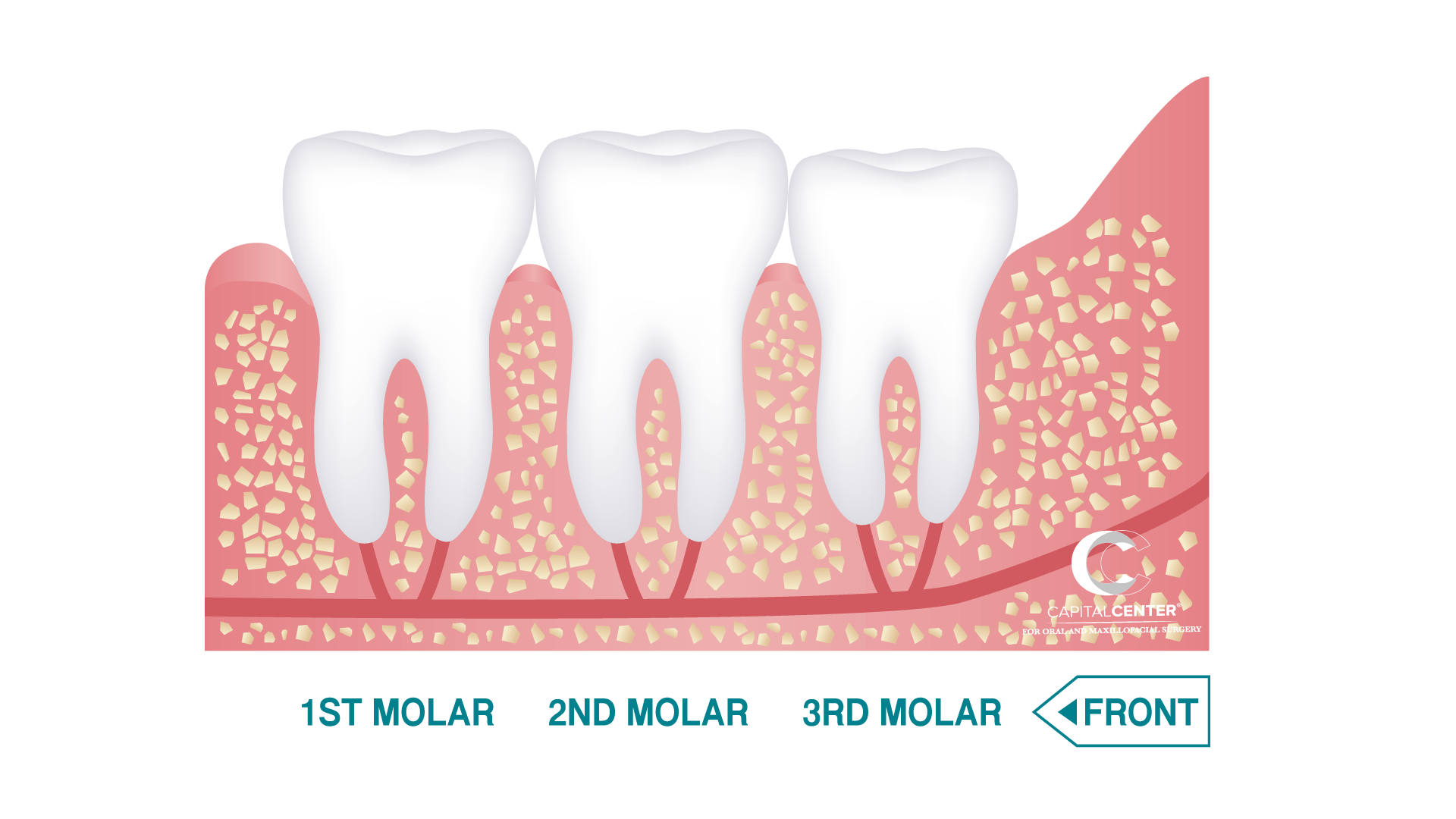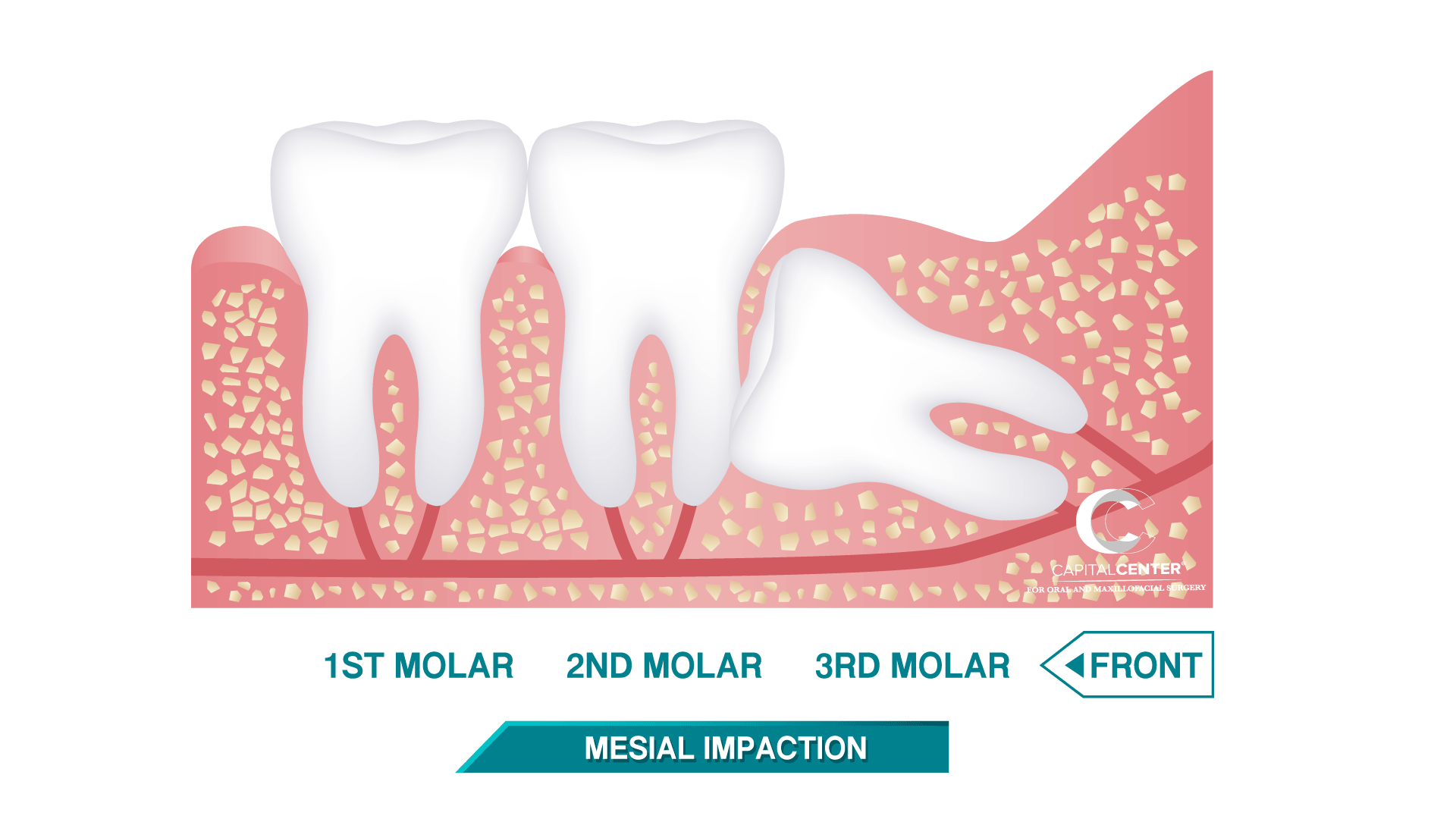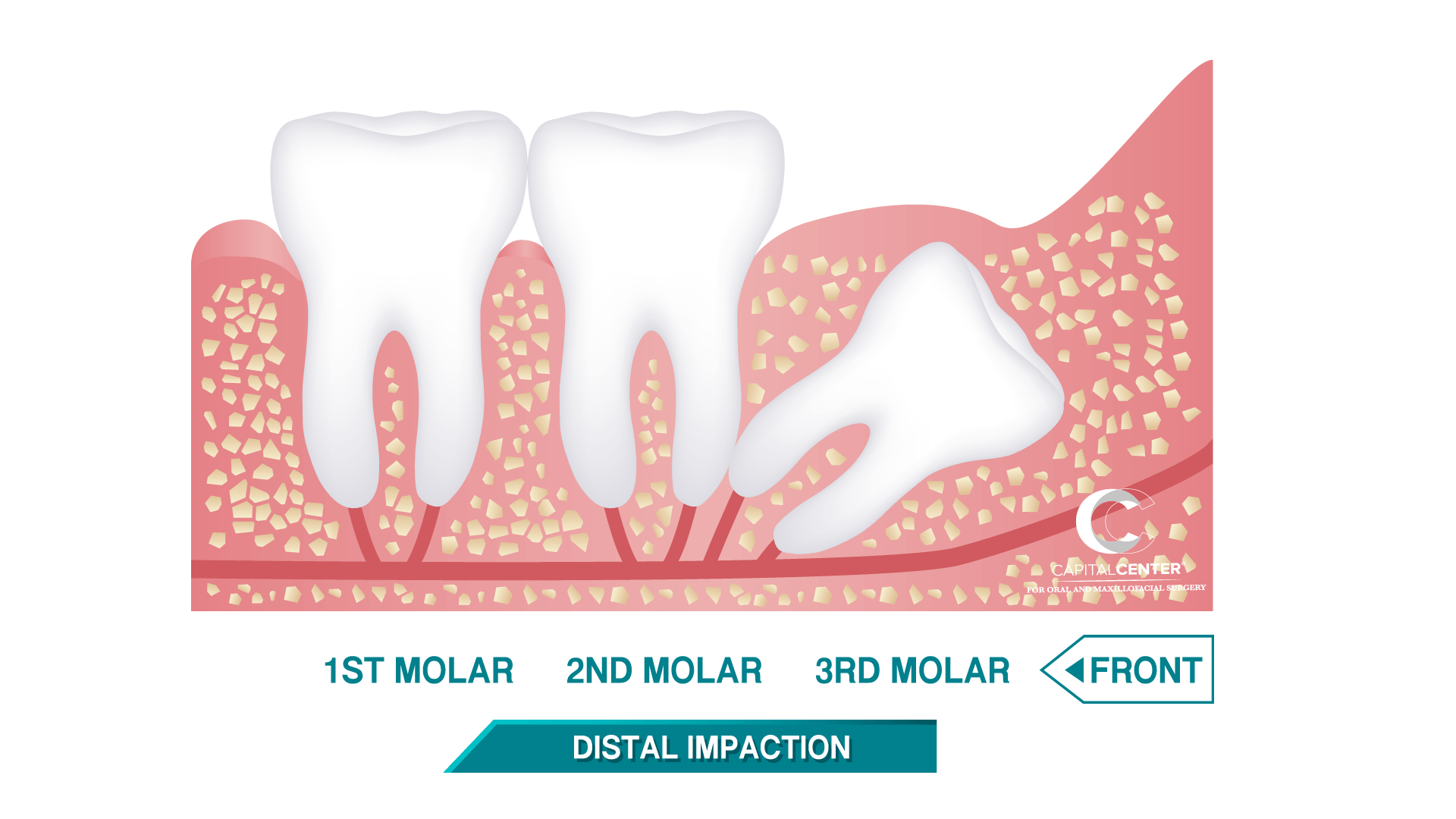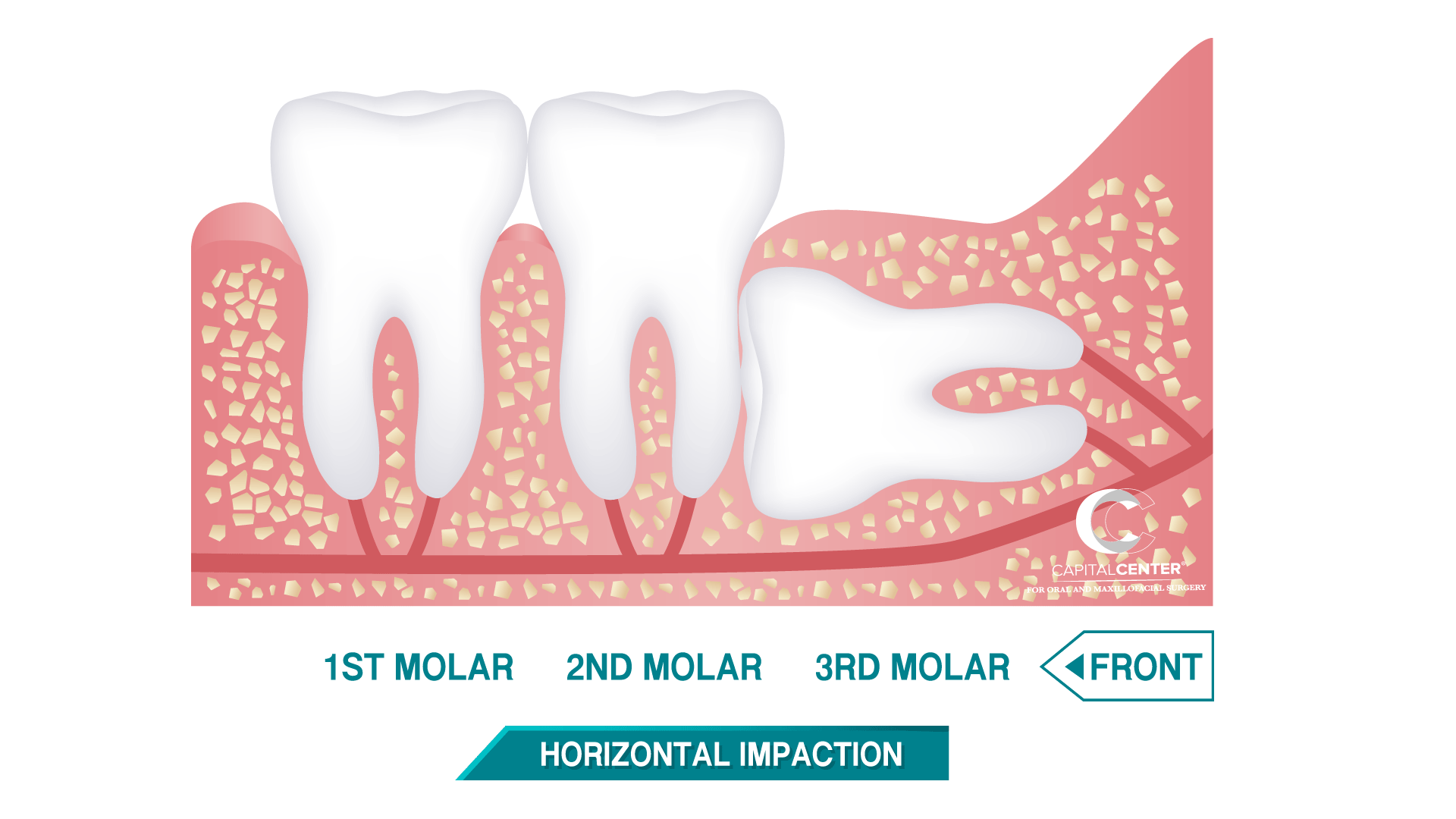Wisdom Teeth Removal
Wisdom teeth, or third molars, are typically the last teeth to erupt into the mouth. For some people, these teeth emerge normally and without problems. However, many other people opt for wisdom teeth removal, either to promote a healthy, beautiful smile for years to come or to resolve issues that have developed because the wisdom teeth weren’t extracted previously.
As oral and maxillofacial specialists with decades of experience, our doctors have performed hundreds of wisdom teeth removal procedures. Patients and families in the area rely on our practice in part because of the skill and innovative techniques we bring to their treatment and in part for the personal and attentive care we offer.

Impacted Wisdom Teeth
When a tooth fails to come fully into the mouth and has no potential to ever do so, it said to be IMPACTED. An impacted tooth can lead to a number of health problems. It may crowd or damage adjacent teeth or roots.

A vertical impaction occurs when the tooth is positioned almost perfectly, but it is still hard to push through the gum line. This type of impacted tooth very rarely requires extraction. An Oral Surgeon may recommend surgery if the impacted tooth pushes against the bottom of the molar in from of it or causes pressure against the bone.

Of all the types of impactions, mesial impaction is the most common. In this type of impaction, the wisdom tooth is tilted so that the top of the tooth angles towards the front of the mouth. This causes the wisdom tooth to press against the nearby molar.

Distal impaction is the least common type of wisdom tooth impaction. It is the opposite of mesial impaction in that the top of the wisdom tooth angles towards the back of the mouth.

Horizontal impaction is typically the most painful type of impacted wisdom teeth, as the tooth lies completely on its side and presses into the molar in front of it. A wisdom tooth with horizontal impaction lies deep within the gum tissue, so the tooth may not be evident without x-rays.
Why are 3D X-RAYS important?
Dental Cone Beam Tomography [Dental CBCT] is a specialized type of x-ray that provides more information than conventional dental or facial x-rays. This computerized scan uses advanced technology to generate three-dimensional[3-D] images.
The benefits of a Dental CBCT scan are that it:
- Provides 3-D images of dental structures, soft tissues, nerve paths and bone which are considerably more detailed than conventional two-dimensional dental x-rays.
- Allows for more precise diagnosis and treatment planning.
- Is simple and comfortable to take and can diagnostically image both bone and soft tissue simultaneously.
What to expect During Surgery
Capital Center® for Oral and Maxillofacial Surgery prioritizes patient comfort, safety, and effective outcomes. Our specialists spend significant time in consultation so that patients can choose treatment with confidence. For younger patients, this usually involves their parents as well. Meeting with our doctors gives families the chance to get to know us and our staff and to learn more about the surgery.
During wisdom teeth removal procedures, we use a variety of techniques and resources to improve the patient experience and limit recovery time:
- Pre-operative medications help prevent infection and inflammation.
- A range of anesthetic options allow our patients to be pain-free and completely relaxed in the procedure. As oral and maxillofacial surgeons, we have years of advanced training and certification in anesthesia.
- Antibiotics applied to the surgical site can all but eliminate the risk of dry socket (a low-grade infection common after wisdom teeth removal).
- EXPAREL®, a non-opioid medication, can completely numb the area for 2-3 days without affecting the tongue or lips.
Dr. Robert Emery, the founder of our practice, is also the co-creator of X-GUIDE. This dynamic 3D navigation technology provides an unprecedented vision for surgeons during procedures. Patients with complex needs related to wisdom teeth removal benefit from X-GUIDE, as it allows our doctors to work at a more precise level of detail, resulting in a less invasive procedure.
Procedures take place in our AAAHC-compliant facility, one of the few of its kind. This level of accreditation demonstrates that the practice meets or exceeds nationally-recognized standards for care.
Typically, wisdom teeth removal patients receive both local anesthetic and deep IV sedation. The combination allows patients to be comfortable and relaxed as the procedure takes place. Most people don’t recognize that any time has passed from the moment they sit down in a treatment chair to the moment the surgery is over, and they wake up without pain.
What happens after surgery?
Depending on the Type of Anesthesia you decided, you will rest in our recovery area immediately after surgery. During this recovery time, we will monitor your condition before allowing you to leave for home with your companion.
Before you leave, we will give you specific instructions to follow over the next few days, including regular follow up calls from Capital Center to monitor your health.
Frequently Asked Questions
What are the consequeces of NOT getting my wisdom teeth removed?
Unfortunately, patients can experience a number of complications if they wait to have their wisdom teeth removed. Because there often isn’t enough room for the wisdom teeth, they may not emerge fully from the gums, a problem which is known as impaction. Impacted teeth can press on adjacent teeth, causing pain, misalignment, and even damage. This pain is more than a simple toothache because it can radiate from the teeth all the way throughout the jaw and head. What’s more, sometimes teeth only emerge from the gums partially. This makes it extremely hard for patients to clean the entire tooth, and bacteria can often get under the gums and cause extreme decay. This decay can spread from the wisdom teeth to other teeth in the mouth, contributing to overall poor oral health.
How long will i have to be off work after having wisdom teeth removal surgery?
Because wisdom teeth removal surgery can affect a patient’s diet and requires rest for the healing to begin, most patients take two to three days off work. One of those days off is for the surgery and then the patient should rest comfortably at their home for another day or two. After about a day, it should be no problem for the patient to return to their normal routine. Of course, it’s entirely up to the patient how long they’d like to take off, especially if they have a job that can be more intense than the traditional office setting. Typically, the usual recovery time for patients is about three days to a week – it all depends on how many wisdom teeth were removed and how severely they were impacted.
Are teeth removed if they are not causing any pain?
If the wisdom teeth aren’t causing any pain, it’s possible they may not need to be removed. However, the only way to know for sure is for patients to schedule a consultation at our office. At this consultation, Drs. Emery, Retana, and DiFabio can use X-rays and other technology to see how the wisdom teeth look inside the gums. If the wisdom teeth are impacted or don’t appear to have enough room to emerge, our doctors will recommend their removal, even if the patient isn’t currently experiencing pain. Usually, it’s only a matter of time before pain, tooth damage, and infection start to plague the patient’s mouth. It’s much better to be proactive about wisdom teeth removal, as it can help patients avoid experiencing uncomfortable symptoms.
Should i have all my Wisdom Teeth removed at once?
Generally, it is best to have all the wisdom teeth removed at once. That way the patient only has to deal with one surgery and one recovery period. Because the patient will only have to schedule one operative appointment at our office and undergo sedation one time, a one-time removal can be far cheaper than multiple sessions. What’s more, the recovery time for wisdom teeth removal is the same whether the patient has one tooth or all four teeth extracted. Having them all done in one session can eliminate the number of days a patient needs to take off work or school. Additionally, patients will only need to go on soft food or liquid diet one time, which can often be a struggle as well.
Why don't we have room for wisdom teeth?
The main reason humans no longer have room for wisdom teeth is that our diets have changed. Early humans ate very course diets with high fiber content that was difficult to chew. This tough diet meant we needed very strong jaw muscles to grind and crush this tough diet. As we developed as children, our jaws responded and were larger in the molar areas. If we look at the jaws of early humans, you rarely see impacted teeth. You also do not see many cavities as we also did not have processed sugars. This meant early men did not usually get cavities. As our diets have gotten softer and less fibrous, our jaws have gotten smaller. This means those third molars don’t have any room to move into the jaw. It is too small. The only solution for our patients is to have them removed.
What can i eat after wisdom teeth extraction?
There are plenty of foods for patients to eat after their wisdom teeth extraction at our office. For the first couple of days, patients will want to avoid hard or crunchy foods, as well as chewing in the back of their mouth. They should stick to soft or liquid foods only so that their mouth has time to heal. Some of the best foods include:
- Soup or broth especially blended soups like tomato or pumpkin. It’s important that the soup isn’t too hot or else it could cause irritation.
- Greek yogurt, as it’s packed with protein and vitamins.
- Ice cream, as the coolness can feel great on the mouth.
- Smoothies, as they’re a great way to get nutrients.
- Mashed fruits and vegetables, such as potatoes, bananas, apples, or pumpkins.
To learn more about wisdom teeth removal, schedule a consultation with Capital Center® for Oral and Maxillofacial Surgery online or by calling us at (202) 929 1321.